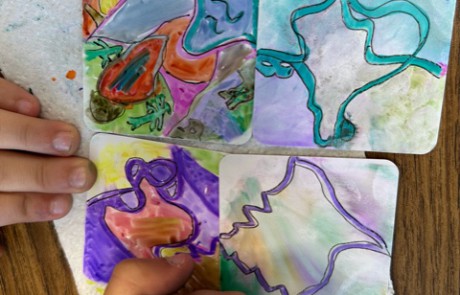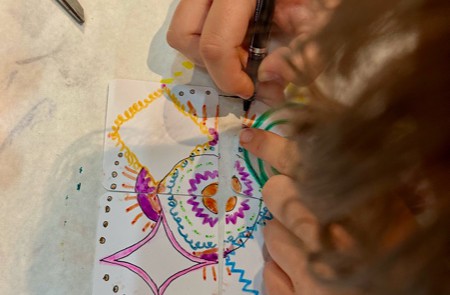Project Description
This conceptual math and life science integrated art residency gets students’ hands and minds busy as they engage with a tactile and diverse assortment of art materials to create both representative and abstract art learning in ways unique to each student.
Through art making, students will experiment with a branch of math we all use daily and may not realize, known as combinatorics, as they make creative choices to design their own set of blank playing cards with ink pens and watercolor markers. The symmetry and set building aspects of combinatorics provide an accessible way to for students to make art while learning a new way to imagine and interact with math.
As illustrative botanists, students will examine a variety of fresh plant material such as leaves, flowers, seed pods, depending on the season, to gather and document observations. Working with soft graphite and paintable watercolor pencils, students will learn color blending, line quality and shading techniques to draw and paint plant portraits in ways that indicate the characteristics they find most fascinating. We’ll discover plant evolution, morphology, adaptations and speculate together about ways plants survive in their habitats.
Both projects are designed to augment confidence building as students find success in math and science.
Chair-based movement is interspersed as a teaching tool throughout.
This residency can be adapted to curriculum that is currently being covered in classes.
Final Product
Students will illustrate their own unique deck of playing cards that allow them to create different designs utilizing combinatorics.
Students will produce sketched, painted and framed botanical portraits.
Learning Outcomes
- Students will gain understanding of math and science topics covered during the residency.
- Students will learn to develop and value their observational skills.
- Students will learn about the differences between abstract and representational art.
- Students will learn to feel confident using experimentation as a method of learning and testing their ideas.
- Students will learn skills necessary for creating collaborative work in an equitable, supportive manner.
- Students will develop art-making skills consistent with the media used and learn corresponding terminology.
- Students will have fun and learn to associate math and science as accessible, welcoming fields of study.
- Students will broaden their understanding of what math and science can be and translate the new meaning to include confidence in, curiosity about, and enthusiasm for often feared subjects.
Suggested Grades
Appropriate for all grade levels.
Pricing Breakdown
- 4 visits at 45 minutes each
- Prep hours: 2 hours per classroom
- Materials: $2 per student
- Travel from Corvallis
Why I teach art:
“Art is a universal language that provides access points to learning, opens doors to self expression and offers opportunities for exploration. I teach art because I want students to believe that their ideas are valid and worth exploring and art is a means I can offer to facilitate their discoveries. I enter each class, meet every student with the intention that they’ll be inspired by the glow of their own creative courage to carry into their days.”
—Victoria Wills










